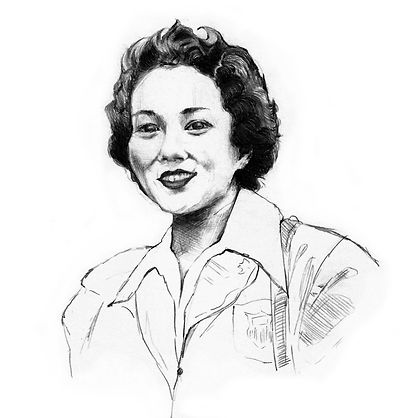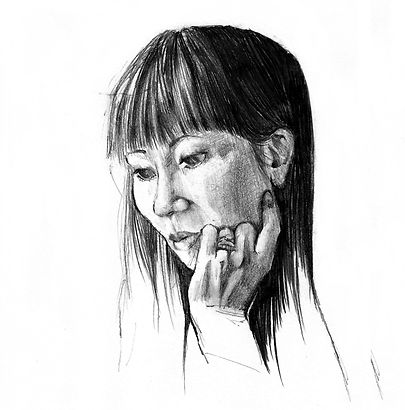AAPI Women in Arts & Entertainment

Ruth Asawa
1926–2013
“Sometimes good comes through adversity. I would not be who I am today had it not been for the internment, and I like who I am.”
Ruth Asawa was an American sculptor who created abstract wire sculptures representing the beauty of organic and life-like forms. Her works have been exhibited around the world and have proven to have a lasting influence in the modern art community. In addition to her artwork, Asawa was devoted to the founding of public arts education in San Francisco. She helped found the Alvarado School Arts Workshop in 1968, connecting professional artists to public school classrooms to help engage students in art. In honor of her achievements and contributions in the art world, the US Postal Service released a series of stamps in 2020 featuring her intricate wire sculptures.
Learn more:

Margaret Cho
b. 1968
“The power of visibility can never be underestimated.”
Margaret Cho is a Korean American comedian and actress who uses her platform to advocate for racial equality, LGBTQ rights, feminism, and other critical issues. She was propelled into fame after starring in the groundbreaking 1994 ABC sitcom “All-American Girl”, the first ever all-Asian sitcom. She also appeared in several talk shows including Jerry Seinfeld's "Comedians in Cars Getting Coffee" in 2016 and “The Arsenio Hall Show” in 1993. Later on, she created multiple stand up films about her struggles as an Asian-American woman comedian. Cho is most known for her stand-up routines where she focuses on social and political issues and comments on disparities in society.
Learn more:


Victoria Manalo Draves
1924–2010
“I’d say to any young people, if they have dreams to follow them, see them all the way through no matter what it takes.”
Victoria Manolo Draves was one of the most significant Asian American athletes, being the first woman to champion the Olympic diving games and the first Asian American to take home a gold medal in 1948. However, what is most impressive about her career is her fight for success. She faced extreme discrimination due to her biracial identity, being denied access to training and being forced to give up her Filipino last name. Draves’ journey represents the struggle of Asian Americans during the mid-1900’s but also of perseverance, as she was able to reclaim her Filipino American identity despite the many obstacles she faced.
Learn more:
The Kim Sisters
years active: 1950s-80s
The Kim Sisters, America’s first K-pop stars, have paved the way for the K-pop stars of today. They started out performing as a triplet of young sisters to American soldiers during the Korean War to support their family. For about five years while performing in their native Korea, they caught the eye of a Las Vegas producer, Tom Ball, who connected the sisters with a manager in LA. For about a decade, the group experienced mass success, performing on popular shows and venues, all while sending money home to continue to support their family. Despite their falling out in the mid-70s, they introduced Korean culture to Americans who were genuinely eager to learn. This was among the first positive reactions to Asian cultures in America, and their legacy still holds today, allowing for current K-pop stars to achieve global success.
Learn more:


Maya Lin
b. 1959
“If we can't face death, we'll never overcome it. You have to look it straight in the eye. Then you can turn around and walk back out into the light.”
Having created several world-renowned memorials, installations, and other public arts, Maya Lin is a world respected artist and architect. At the age of 21, she designed the Vietnam Veterans Memorial in 1981, a massive memorial on the National Mall honoring approximately 58,000 men and women veterans who died serving the Vietnam War. This famous piece opened the door to groundbreaking success, as she went on to create a multitude of renowned works. Many of Lin’s works combat societal issues; most notably she has raised significant awareness for climate change in her works ‘Ghost Forest’, ‘What is Missing?’, and many more. She was awarded the 2016 Presidential Medal of Freedom for her dedication to sustainability in her art and the 2009 National Medal of Arts.
Learn more:
Amy Tan
b. 1952
“Everyone must dream. We dream to give ourselves hope. To stop dreaming—well, that's like saying you can never change your fate. Isn't that true?” (The Hundred Secret Senses)
Amy Tan stands as one of the most influential Asian American writers as the author of The Joy Luck Club, The Bonesetter’s Daughter, The Kitchen God’s Wife, and many more bestsellers. Her writings focus on the theme of complex relationships and structures in Asian American families, and many of her works draw inspiration from the lives of her family members. Specifically, Tan reveals how those structures develop over time and affect the lives of those involved. Her novels not only serve as an outlet for her life experiences, they have become a source for readers to identify with and relate to. Because of her contributions, Tan is the recipient of the 2005 Commonwealth Award and was nominated for several other literary awards including the National Book Award.
Learn more:


Anna May Wong
1905–1961
“Why is it that the screen Chinese is always the villain? And so crude a villain—murderous, treacherous, a snake in the grass! We are not like that. How could we be, with a civilization that is so many times older than the West?”
Being the first Asian American woman awarded a star on Hollywood's Walk of Fame in 1960, Anna May Wong has paved the path, breaking barriers and stereotypes for Asian American actors in Hollywood. She refused to be typecast as the stereotypical "twentieth-century Hollywood Asian," oftentimes depicted as the crude, uncivilized villain. Instead, she fought against this typical depiction and advocated to humanize Asian American roles in Hollywood. She starred in films like "The Toll of the Sea" (1923), "Shanghai Express" (1932), and "The Thief Of Bagdad" (1924). Wong was met with continued discrimination in her field; she lost a lead role to a white actress in yellowface in the 1937 film "The Good Earth." But Wong’s legacy lives on and in 2022, she became the first Asian American featured on U.S. currency.
Learn more:
